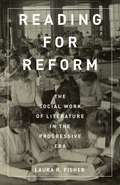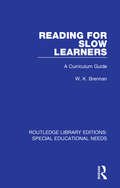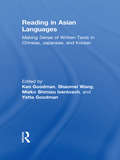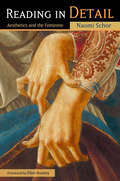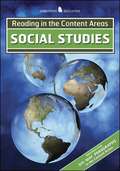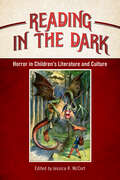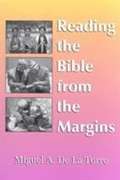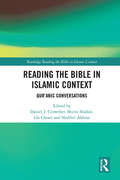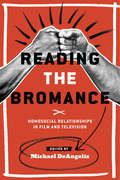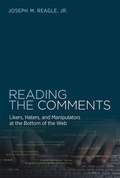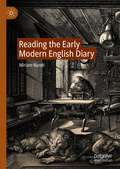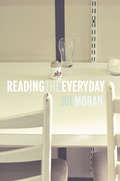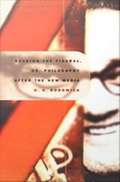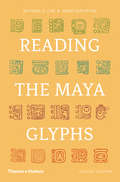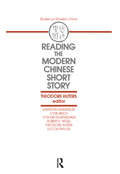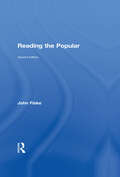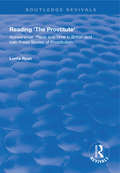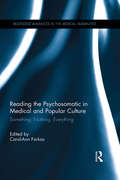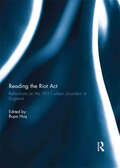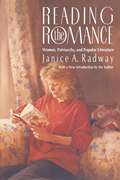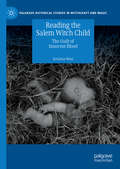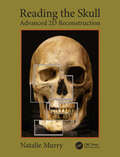- Table View
- List View
Reading for Reform: The Social Work of Literature in the Progressive Era
by Laura R. FisherAn unprecedented examination of class-bridging reform and U.S. literary history at the turn of the twentieth century Reading for Reform rewrites the literary history of late nineteenth and early twentieth century America by putting social reform institutions at the center of literary and cultural analysis. Examining the vibrant, often fractious literary cultures that developed as part of the Progressive mandate to uplift the socially disadvantaged, it shows that in these years reformers saw literature as a way to combat the myriad social problems that plagued modern U.S. society. As they developed distinctly literary methods for Americanizing immigrants, uplifting and refining wage-earning women, and educating black students, their institutions gave rise to a new social purpose for literature.Class-bridging reform institutions—the urban settlement house, working girls&’ club, and African American college—are rarely addressed in literary history. Yet, Laura R. Fisher argues, they engendered important experiments in the form and social utility of American literature, from minor texts of Yiddish drama and little-known periodical and reform writers to the fiction of Edith Wharton and Nella Larsen. Fisher delves into reform&’s vast and largely unexplored institutional archives to show how dynamic sites of modern literary culture developed at the margins of social power. Fisher reveals how reformist approaches to race, class, religion, and gender formation shaped American literature between the 1880s and the 1920s. In doing so, she tells a new story about the fate of literary practice, and the idea of literature&’s practical value, during the very years that modernist authors were proclaiming art&’s autonomy from concepts of social utility.
Reading for Slow Learners: A Curriculum Guide (Routledge Library Editions: Special Educational Needs #5)
by W. K. BrennanFirst published in 1978. Reading for Slow Learners is a practical guide for teachers, defining the objectives of the reading curriculum, identifying important aspects of teaching method and suggesting various approaches. This title will also be of interest to parents of children with learning difficulties.
Reading in Asian Languages: Making Sense of Written Texts in Chinese, Japanese, and Korean
by Yetta Goodman Ken Goodman Shaomei Wang Mieko Shimizu IventoschReading in Asian Languages is rich with information about how literacy works in the non-alphabetic writing systems (Chinese, Japanese, Korean) used by hundreds of millions of people and refutes the common Western belief that such systems are hard to learn or to use. The contributors share a comprehensive view of reading as construction of meaning which they show is fully applicable to character-based reading. The book explains how and why non-alphabetic writing works well for its users; provides explanations for why it is no more difficult for children to learn than are alphabetic writing systems where they are used; and demonstrates in a number of ways that there is a single process of making sense of written language regardless of the orthography. Unique in its perspective and offering practical theory-based methodology for the teaching of literacy in Chinese, Japanese, and Korean to first and second language learners, it is a useful resource for teachers of increasingly popular courses in these languages in North America as well as for teachers and researchers in Asia. It will stimulate innovation in both research and instruction.
Reading in Detail: Aesthetics and the Feminine
by Naomi SchorWho cares about details? As Naomi Schor explains in her highly influential book, we do-but it has not always been so. The interest in detail--in art, in literature, and as an aesthetic category--is the product of the decline of classicism and the rise of realism.But the story of the detail is as political as it is aesthetic. Secularization, the disciplining of society, the rise of consumerism, the invention of the quotidian, have all brought detail to the fore. In this classic work of aesthetic and feminist theory, now available in a new paperback edition, Schor provides ways of thinking about details and ornament in literature, art, and architecture, and uncovering the unspoken but powerful ideologies that attached gender to details. Wide-ranging and richly argued, Reading in Detail presents ideas about reading (and viewing) that will enhance the study of literature and the arts.
Reading in the Content Areas: Social Studies
by McGraw-Hill Education StaffBased on the best-selling Six-Way Paragraphs books, these individual titles help students master the essential skills needed to organize, understand, and apply information in math, science, and social studies. Here are the books that will open doors for you into your content area classrooms.
Reading in the Dark: Horror in Children's Literature and Culture (Children's Literature Association Series)
by Jessica R. McCortContributions by Rebecca A. Brown, Justine Gieni, Holly Harper, Emily L. Hiltz, A. Robin Hoffman, Kirsten Kowalewski, Peter C. Kunze, Jorie Lagerwey, Nick Levey, Jessica R. McCort, and Janani SubramanianDark novels, shows, and films targeted toward children and young adults are proliferating wildly. It is even more crucial now to understand the methods by which such texts have traditionally operated and how those methods have been challenged, abandoned, and appropriated. Reading in the Dark fills a gap in criticism devoted to children's popular culture by concentrating on horror, an often-neglected genre. These scholars explore the intersection between horror, popular culture, and children's cultural productions, including picture books, fairy tales, young adult literature, television, and monster movies.Reading in the Dark looks at horror texts for children with deserved respect, weighing the multitude of benefits they can provide for young readers and viewers. Refusing to write off the horror genre as campy, trite, or deforming, these essays instead recognize many of the texts and films categorized as "scary" as among those most widely consumed by children and young adults. In addition, scholars consider how adult horror has been domesticated by children's literature and culture, with authors and screenwriters turning that which was once horrifying into safe, funny, and delightful books and films. Scholars likewise examine the impetus behind such re-envisioning of the adult horror novel or film as something appropriate for the young. The collection investigates both the constructive and the troublesome aspects of scary books, movies, and television shows targeted toward children and young adults. It considers the complex mechanisms by which these texts communicate overt messages and hidden agendas, and it treats as well the readers' experiences of such mechanisms.
Reading the Bible From the Margins
by Miguel A. De La TorreDescribing how "standard" readings of the Bible are not always acceptable to people or groups on the "margins," this book afters valuable new insights into biblical texts today.
Reading the Bible in Islamic Context: Qur'anic Conversations (Routledge Reading the Bible in Islamic Context Series)
by Shirin Shafaie Shabbir Akhtar Daniel J Crowther Ida GlaserIn the current political and social climate, there is increasing demand for a deeper understanding of Muslims, the Qur’an and Islam, as well as a keen demand among Muslim scholars to explore ways of engaging with Christians theologically, culturally, and socially. This book explores the ways in which an awareness of Islam and the Qur’an can change the way in which the Bible is read. The contributors come from both Muslim and Christian backgrounds, bring various levels of commitment to the Qur’an and the Bible as Scripture, and often have significantly different perspectives. The first section of the book contains chapters that compare the report of an event in the Bible with a report of the same event in the Qur’an. The second section addresses Muslim readings of the Bible and biblical tradition and looks at how Muslims might regard the Bible - Can they recognise it as Scripture? If so, what does that mean, and how does it relate to the Qur’an as Scripture? Similarly, how might Christian readers regard the Qur’an? The final section explores different analogies for understanding the Bible in relation to the Qur’an. The book concludes with a reflection upon the particular challenges that await Muslim scholars who seek to respond to Jewish and Christian understandings of the Jewish and Christian scriptures. A pioneering venture into intertextual reading, this book has important implications for relationships between Christians and Muslims. It will be of significant value to scholars of both Biblical and Qur’anic Studies, as well as any Muslim seeking to deepen their understanding of the Bible, and any Christian looking to transform the way in which they read the Bible.
Reading the Bromance: Homosocial Relationships in Film and Television
by Michael DeangelisIn the middle of this century's first decade, "bromance" emerged as a term denoting an emotionally intense bond between straight men. Yet bromance requires an expression of intimacy that always toys with being coded as something other than "straight" male behavior, even as it insists that such intimacy must never be misinterpreted. In Reading the Bromance: Homosocial Relationships in Film and Television, editor Michael DeAngelis has compiled a diverse group of essays that address the rise of this tricky phenomenon and explore the social and cultural functions it serves. Contributors consider selected contemporary film and television texts, as well as the genres that historically inspired them, in order to explore what needs bromance attempts to fulfill in relationships between men--straight or otherwise. Essays analyze films ranging from I Love You, Man to Superbad, Humpday, I Now Pronounce You Chuck and Larry, The Hangover, and the Jackass films, and include studies of representative examples in international cinema such as Y tu mama tambien and classic and contemporary films of the Bollywood genre. The volume also examines the increasingly prevalent appearance of the bromance phenomenon in television narratives, from the "male bonding" rituals of Friends and Seinfeld to more recent manifestations in House, The Wire, and the MTV reality series Bromance. From historical analysis to discourse analysis, sociological analysis, and queer theory, this volume provides a broad range of methodological and theoretical approaches to the phenomenon in the first booklength study of the bromance genre. Film and television scholars as well as readers interested in pop culture and queer studies will enjoy the insights of Reading the Bromance.
Reading the Comments
by Joseph M. ReagleOnline comment can be informative or misleading, entertaining or maddening. Haters and manipulators often seem to monopolize the conversation. Some comments are off-topic, or even topic-less. In this book, Joseph Reagle urges us to read the comments. Conversations "on the bottom half of the Internet," he argues, can tell us much about human nature and social behavior.Reagle visits communities of Amazon reviewers, fan fiction authors, online learners, scammers, freethinkers, and mean kids. He shows how comment can inform us (through reviews), improve us (through feedback), manipulate us (through fakery), alienate us (through hate), shape us (through social comparison), and perplex us. He finds pre-Internet historical antecedents of online comment in Michelin stars, professional criticism, and the wisdom of crowds. He discusses the techniques of online fakery (distinguishing makers, fakers, and takers), describes the emotional work of receiving and giving feedback, and examines the culture of trolls and haters, bullying, and misogyny. He considers the way comment -- a nonstop stream of social quantification and ranking -- affects our self-esteem and well-being. And he examines how comment is puzzling -- short and asynchronous, these messages can be slap-dash, confusing, amusing, revealing, and weird, shedding context in their passage through the Internet, prompting readers to comment in turn, "WTF?!?"
Reading the Comments: Likers, Haters, and Manipulators at the Bottom of the Web (The\mit Press Ser.)
by Joseph M. ReagleWhat we can learn about human nature from the informative, manipulative, confusing, and amusing messages at the bottom of the web.Online comment can be informative or misleading, entertaining or maddening. Haters and manipulators often seem to monopolize the conversation. Some comments are off-topic, or even topic-less. In this book, Joseph Reagle urges us to read the comments. Conversations “on the bottom half of the Internet,” he argues, can tell us much about human nature and social behavior.Reagle visits communities of Amazon reviewers, fan fiction authors, online learners, scammers, freethinkers, and mean kids. He shows how comment can inform us (through reviews), improve us (through feedback), manipulate us (through fakery), alienate us (through hate), shape us (through social comparison), and perplex us. He finds pre-Internet historical antecedents of online comment in Michelin stars, professional criticism, and the wisdom of crowds. He discusses the techniques of online fakery (distinguishing makers, fakers, and takers), describes the emotional work of receiving and giving feedback, and examines the culture of trolls and haters, bullying, and misogyny. He considers the way comment—a nonstop stream of social quantification and ranking—affects our self-esteem and well-being. And he examines how comment is puzzling—short and asynchronous, these messages can be slap-dash, confusing, amusing, revealing, and weird, shedding context in their passage through the Internet, prompting readers to comment in turn, “WTF?!?”
Reading the Diaries of Henry Trent: The Everyday Life of a Canadian Englishman, 1842-1898 (McGill-Queen's Rural, Wildland, and Resource Studies)
by J.I. LittleThe personal journals examined in Reading the Diaries of Henry Trent are not the witty, erudite, and gracefully written exercises that have drawn the attention of most biographers and literary scholars. Prosaic, ungrammatical, and poorly spelled, the fifteen surviving volumes of Henry Trent's hitherto unexamined diaries are nevertheless a treasure for the social and cultural historian.Henry Trent was born in England in 1826, the son of a British naval officer. When he was still a boy, his father decided to begin a new life as a landed gentleman and moved the family to Lower Canada. At the age of sixteen Trent began writing in a diary, which he maintained, intermittently, for more than fifty years. As a lonely youth he narrates days spent hunting and trapping in the woods owned by his father. On the threshold of manhood and in search of a vocation, he writes about his experiences in London and then on Vancouver Island during the gold rush. And finally, as the father of a large family, he describes the daily struggle to make ends meet on the farm he inherited in Quebec's lower St Francis valley.As it follows Trent through the different stages of his long life, Reading the Diaries of Henry Trent explores the complexities of class and colonialism, gender roles within the rural family, and the transition from youth to manhood to old age. The diaries provide a rare opportunity to read the thoughts and follow the experiences of a man who, like many Victorian-era immigrants of the privileged class, struggled to adapt to the Canadian environment during the rise of the industrial age.
Reading the Early Modern English Diary
by Miriam NandiReading the Early Modern Diary traces the historical genealogy, formal characteristics, and shifting cultural uses of the early modern English diary. It explores the possibilities and limitations the genre held for the self-expression of a writer at a time which considerably pre-dated the Romantic cult of the individual self. The book analyzes the connections between genre and self-articulation: How could the diary come to be associated with emotional self-expression given the tedium and repetitiveness of its early seventeenth-century ancestors? How did what were once mere lists of daily events evolve into narrative representations of inner emotions? What did it mean to write on a daily basis, when the proper use of time was a heavily contested issue? Reading the Early Modern Diary addresses these questions and develops new theoretical frameworks for discussing interiority and affect in early modern autobiographical texts.
Reading the Everyday
by Joe MoranIn an ever-growing field of study, this is a major contribution to one of the key areas in cultural studies and cultural theory – the spaces, practices and mythologies of our everyday culture. Drawing on the work of such continental theorists as Henri Lefebvre, Michel de Certeau, Marc Augé and Siegfried Kracauer, Joe Moran explores the concrete sites and routines of everyday life and how they are represented through political discourse, news media, material culture, photography, reality TV shows, CCTV and much more. Unique in his focus of the under-explored, banal aspects of everyday culture, including office life, commuting, traffic and mass housing, Moran re-evaluates conventional notions of everyday life in cultural studies, and shows that analysing such ‘boring’ phenomena can help make sense of cultural and social change. This book is interdisciplinary in its approach and covers many different areas including visual culture, cultural geography, material culture, and cultural history as well as the key areas of cultural studies and sociology. Students from all these subjects will find this clearly written and lively work an invaluable study resource.
Reading the Figural: Or, Philosophy After the New Media
by D. N. RodowickIn Reading the Figural, or, Philosophy after the New Media D. N. Rodowick applies the concept of "the figural" to a variety of philosophical and aesthetic issues. Inspired by the aesthetic philosophy of Jean-Franois Lyotard, the figural defines a semiotic regime where the distinction between linguistic and plastic representation breaks down. This opposition, which has been the philosophical foundation of aesthetics since the eighteenth century, has been explicitly challenged by the new electronic, televisual, and digital media. Rodowick--one of the foremost film theorists writing today--contemplates this challenge, describing and critiquing the new regime of signs and new ways of thinking that such media have inaugurated. To fully comprehend the emergence of the figural requires a genealogical critique of the aesthetic, Rodowick claims. Seeking allies in this effort to deconstruct the opposition of word and image and to create new concepts for comprehending the figural, he journeys through a range of philosophical writings: Thierry Kuntzel and Marie-Claire Ropars-Wuilleumier on film theory; Jacques Derrida on the deconstruction of the aesthetic; Siegfried Kracauer and Walter Benjamin on the historical image as a utopian force in photography and film; and Gilles Deleuze and Michel Foucault on the emergence of the figural as both a semiotic regime and a new stratagem of power coincident with the appearance of digital phenomena and of societies of control. Scholars of philosophy, film theory, cultural criticism, new media, and art history will be interested in the original and sophisticated insights found in this book.
Reading the Impossible: Sexual Difference, Critique, and the Stamp of History
by Elizabeth WeedReading the impossible has never seemed less possible. A few decades ago, critical readings could view the collapse of foundationalism optimistically. With meaning no longer soldered onto being, there was hope for all those beings whose meaning had been forever ordained by Nature or the Divine. Critical reading thus became a way of exploring the devious workings of knowledge and power. But as non-foundational systems of meaning have proven to be so perfectly suited to the transactional logics of the market, reading for the impasses of meaning has come to be seen as quixotic, impractical, and dated. To concur with that view, Elizabeth Weed argues, is to embrace the fantasy told by the neoliberal order. To read the impossible is to disrupt that fantasy, with its return to stable categories of marketable identity, in order to contest the inexorable workings of misogyny and racism. This book seeks to disturb the positivity of identity in the hope of retrieving the impossibility of sexual difference, an impossibility that has its effects in the Real of misogyny.A return to the famous debate between Derrida and Lacan on the impossibility of sexual difference yields two different readings of the impossible. In reconsidering these questions, Weed shows how the practice of reading can powerfully stage the wiles of language and the unconscious. In returning to that earlier moment in the context of current debates on the role of reading and interpretation, Weed offers a fresh perspective on what is at stake for critical reading in the neoliberal university.
Reading the Maya Glyphs (Second Edition)
by Michael D. Coe Mark Van StoneThe breaking of the Maya code has completely changed our knowledge of this ancient civilization, and has revealed the Maya people's long and vivid history. Decipherment of Maya hieroglyphic writing has progressed to the point where most Maya written texts—whether inscribed on monuments, written in the codices, or painted or incised on ceramics—can now be read with confidence. In this practical guide, first published in 2001, Michael D. Coe, the noted Mayanist, and Mark Van Stone, an accomplished calligrapher, have made the difficult, often mysterious script accessible to the nonspecialist. They decipher real Maya texts, and the transcriptions include a picture of the glyph, the pronunciation, the Maya words in Roman type, and the translation into English. For the second edition, the authors have taken the latest research and breakthroughs into account, adding glyphs, updating captions, and reinterpreting or expanding upon earlier decipherments. After an introductory discussion of Maya culture and history and the nature of the Maya script, the authors introduce the glyphs in a series of chapters that elaborate on topics such as the intricate calendar, warfare, royal lives and rituals, politics, dynastic names, ceramics, relationships, and the supernatural world. The book includes illustrations of historic texts, a syllabary, a lexicon, and translation exercises.
Reading the Modern Chinese Short Story (Studies On Modern China)
by Theodore HutersTranslations of six stories accompany seven papers from a workshop on critical approaches to modern Chinese short stories held at the U. of Hawaii in December 1982. With one exception, the essays analyze the stories presented, looking at such factors as the psychological structure, the narrator, ide
Reading the Popular
by John FiskeThis revised edition of a now classic text includes a new introduction by Henry Jenkins, explaining ‘Why Fiske Still Matters’ for today’s students, followed by a discussion between former Fiske students Kevin Glynn, Jonathan Gray, and Pamela Wilson on the theme of ‘Reading Fiske and Understanding the Popular’. Both underline the continuing relevance of this foundational text in the study of popular culture. Beneath the surface of the cultural artifacts that surround us – shopping malls, popular music, the various forms of television – lies a multitude of meanings and ways of using them, not all of them those intended by their designers. In Reading the Popular, John Fiske analyzes these popular "texts" to reveal both their explicit and implicit (and often opposite) meanings and uses, and the social and political dynamics they reflect. Fiske’s "readings" of these cultural phenomena highlight the conflicting responses they evoke: Madonna may be promoted as a "boy toy", but young girls feel empowered by her ability to toy with boys; Chicago’s Sears Tower may be a massive expression of capitalist domination, but it can also allow one to tower over the city. In each case it is the latter option that interests him, for this is where Fiske locates popular culture: it is the point at which people take the goods offered them by industrial capitalism (however oppressive they may seem) and turn them to their own creative, and even subversive, uses. Designed as a companion to Understanding Popular Culture, Reading the Popular gives the lie to theories that portray a mass audience that mindlessly consumes every product it is offered. Fiske’s acute perception and lively wit combine to provide a truly democratic vision of popular culture, one that respects the awareness and the agency of the people who make it.
Reading the Prostitute: Appearance, Place and Time in British and Irish Press Stories of Prostitution (Routledge Revivals)
by Lorna RyanFirst published in 1997, this study aims to forge new connections between debates on prostitution, media processes and everyday life in its exploration of depictions of female prostitution in British and Irish broadsheet newspapers between 1987 and 1991. Lorna Ryan first examines a range of discourses on prostitution before proceeding to areas including signals of prostitution and images in the press. Encompassing both textual and visual analyses, Ryan demonstrates that these newspapers relied on appearance, place, time, motive and intent in categorising women as prostitutes.
Reading the Psychosomatic in Medical and Popular Culture: Something. Nothing. Everything (Routledge Advances in the Medical Humanities)
by Carol-Ann FarkasPain. Chronic digestive symptoms. Poor sleep. Neuropathy. Sensory disturbances. Fatigue. Panic. Constant illness and discomfort. Frequent difficulty coping with work, school, relationships. Despite the common experience of being told that it’s all in their heads, that they’re just making themselves sick, individuals with these symptoms are experiencing a very real, sometimes debilitating, illness phenomenon. But what is it? Physical or mental illness? Political or social identity? Cultural, narrative, or discursive construction? When something goes awry at the intersection of mind and body – the psychosomatic – what is happening? Widely recognized, yet difficult to classify, diagnose, treat, and explain, psychosomatic disorders are heavily stigmatized, and the associated syndromes have become the site of controversy and antipathy in the provider–patient relationship. In popular culture, terms such as medically unexplained symptoms, hysteria, neurasthenia, hypochondria, functional illness, and malingering are misunderstood, unknown, or rejected outright. Meanwhile, perspectives from cultural and textual studies focus on the psychosomatic as a metaphor in art, literature, and popular media, where disruptions of the body and mind are regularly made to stand in for individual alienation and cultural malaise. Bringing together multiple perspectives, this challenging volume tackles causes, and innovative, humanistic solutions, to conflicts in the provider–patient relationship; uses the psychosomatic as a lens for theorizing the self in culture; and examines the metaphorical potential of the psychosomatic in fictional narrative. Providing a unique assemblage of interdisciplinary, international approaches to understanding the problem of the psychosomatic in both expert and lay discourses, this pioneering edited collection is aimed at students and researchers of health, popular culture, and the health care humanities.
Reading the Riot Act: Reflections on the 2011 urban disorders in England
by Rupa HuqThis lively collection presents a multi-disciplinary, multi-perspectival commentary explaining the what, where, and how of the riots that the austerity-hit UK experienced during the long, hot summer of 2011. It looks beyond London and its Tottenham district where disturbances started, to locations such as Manchester and Birmingham. Parallels are drawn with Cairo during the period of the Arab spring, and even with the Star Wars saga. The book locates the riots in historical context by looking at the previous UK riots of 1981 and 2001, looking at how news cycles and concepts such as that of ‘moral panic’ have changed in the age of social networking. It is essential reading for anyone interested in contemporary debates in social policy, media studies, anthropology sociology, cultural studies, and human geography. This book was originally published as a special issue of the Journal for Cultural Research.
Reading the Romance
by Janice A. RadwayOriginally published in 1984, Reading the Romance challenges popular (and often demeaning) myths about why romantic fiction, one of publishing's most lucrative categories, captivates millions of women readers. Among those who have disparaged romance reading are feminists, literary critics, and theorists of mass culture. They claim that romances enforce the woman reader's dependence on men and acceptance of the repressive ideology purveyed by popular culture. Radway questions such claims, arguing that critical attention "must shift from the text itself, taken in isolation, to the complex social event of reading." She examines that event, from the complicated business of publishing and distribution to the individual reader's engagement with the text.Radway's provocative approach combines reader-response criticism with anthropology and feminist psychology. Asking readers themselves to explore their reading motives, habits, and rewards, she conducted interviews in a midwestern town with forty-two romance readers whom she met through Dorothy Evans, a chain bookstore employee who has earned a reputation as an expert on romantic fiction. Evans defends her customers' choice of entertainment; reading romances, she tells Radway, is no more harmful than watching sports on television."We read books so we won't cry" is the poignant explanation one woman offers for her reading habit. Indeed, Radway found that while the women she studied devote themselves to nurturing their families, these wives and mothers receive insufficient devotion or nurturance in return. In romances the women find not only escape from the demanding and often tiresome routines of their lives but also a hero who supplies the tenderness and admiring attention that they have learned not to expect.The heroines admired by Radway's group defy the expected stereotypes; they are strong, independent, and intelligent. That such characters often find themselves to be victims of male aggression and almost always resign themselves to accepting conventional roles in life has less to do, Radway argues, with the women readers' fantasies and choices than with their need to deal with a fear of masculine dominance.These romance readers resent not only the limited choices in their own lives but the patronizing atitude that men especially express toward their reading tastes. In fact, women read romances both to protest and to escape temporarily the narrowly defined role prescribed for them by a patriarchal culture. Paradoxically, the books that they read make conventional roles for women seem desirable. It is this complex relationship between culture, text, and woman reader that Radway urges feminists to address. Romance readers, she argues, should be encouraged to deliver their protests in the arena of actual social relations rather than to act them out in the solitude of the imagination.In a new introduction, Janice Radway places the book within the context of current scholarship and offers both an explanation and critique of the study's limitations.
Reading the Salem Witch Child: The Guilt of Innocent Blood (Palgrave Historical Studies in Witchcraft and Magic)
by Kristina WestThis book discusses the role of children in the Salem witch trials through a close reading of the many and varied narratives of the trials, including court records, contemporary and historical documents, fiction, drama, and poetry. Taking a critical theory approach to explore both what we might understand as a child in 1692 New England and to consider our adult investment in reading the child, Kristina West explores narratives of the afflicted girls and the many accused children whom are often absent or overlooked in histories, and considers how the trial structure is continually repeated in attempts to establish the respective guilt and innocence of these and other groups. This book also analyses later manuscripts and fictional rewritings of the trials to question the basis on which assumptions about the child in history are made, and to consider why such narratives of Salem’s children are still relevant now.
Reading the Skull: Advanced 2D Reconstruction
by Natalie MurryWhile there are a handful of introductory texts and resources on 2D drawing for facial identification and reconstruction, most often they don’t go beyond this cursory presentation of the subject. There is need for an advanced text available for artists who wish to learn more about reading and understanding the skull to inform more accurate and detailed 2D craniofacial reconstruction work. Reading the Skull: Advanced 2D Reconstruction fills this need by providing instruction on how to identify basic features, as well as indicators and anomalies in bone structures, to help in illustrating more specific and unique details in facial structure and features. Since artists are most frequently visual learners, the book presents comparative photos of skulls with life photos to help better identify and decipher distinguishing facial characteristics. Because many forensic artists perform few reconstructions each year— and have very little exposure to skulls— the author has written this text to show examples of distinct elements in the skull for artists to see, compare, and learn. In doing so, it provides those who do not regularly work with skulls more exposure to them and allows readers the ability to apply such information and better extrapolate features for the purpose of more accurately rendering an individual’s unique facial features. When examining the skull closely, each feature can be more detailed based on what the bone is indicating, and the work can be more accurate to that specific skull. Characteristics such as the ears, facial harmony and symmetry, shape of eye and brow, nose and mouth, the aging process, sex and ancestral background— among others— are all singular to that skull and adds to the gestalt of that face to make it more identifiable as an individual. Reading the Skull is a ground- breaking collection of the author’s personal study and research, other published works from the literature on facial features, as well as numerous examples from donors to forensic anthropology centers in the US. Work presented draws upon new information from anthropologists and others in related fields and disciplines who continue to study facial features based on the skull. As such, it provides a fresh perspective, summarizing several studies and work together in a single book. Natalie Murry is a freelance forensic artist currently based in Austin, Texas. She began her forensic art career while working as a police officer in Kent Washington. She does reconstructions and postmortem drawings for the King County Medical Examiner’s Office in Seattle Washington, and the Snohomish County Medical Examiner’s Office in Everett Washington. She has taught forensic artists to draw digitally at workshops at police departments from Washington to New Jersey as well as at Scottsdale Artists School and at the Forensic Anthropology Center at Texas State University. Natalie is on the forensic art subcommittee for the International Association for Identification, and is an IAI certified forensic artist. She has had two articles published in the Journal of Forensic Identification: in September/ October 2015 entitled “Rotating the Anterior View of a Skull into the Frankfort Horizontal Plane for Postmortem Drawings” and in April/ June 2021 entitled “Skull to Photo Comparison for Identification Purposes.” She has been a beta tester for Corel Painter since the 2016 build. Her work can be seen on her website, www.natal iemu rry.com, on Instagram as @NatalieMurryForensicArt, and on Facebook as NatalieMurryForensicArt.
